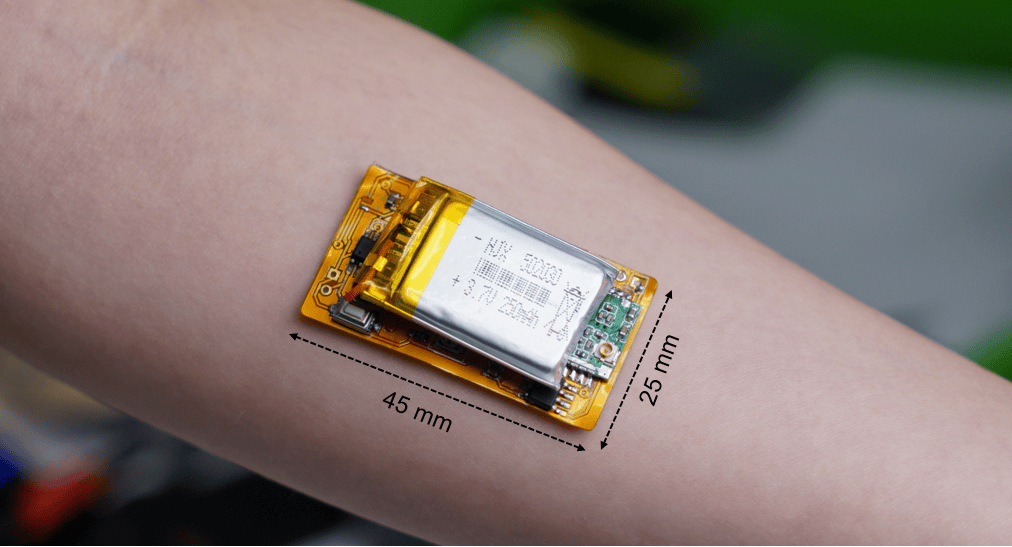Nanofabricated EMG Sensor for Muscle Activity Detection

KEY INFORMATION
Healthcare - Telehealth, Medical Software & Imaging
TECHNOLOGY OVERVIEW
This invention is a portable electromyography (EMG) sensor for muscle activity detection. Unlike conventional EMG devices, which are bulky and confined to clinic settings, the sensor is built to be compact and wearable. It enables real-time, reliable biofeedback regardless of user’s location, bridging the accessibility gap in EMG analysis outside the traditional medical environments. This portability is achieved by integrating reusable micro-structured electrodes and highly integrated sensing system onto a soft and flexible substrate. The design ensures accurate EMG detection while offering a comfortable experience for extended use.
The technology consists of three main components:
- Use of nanofabrication to build the electrodes followed by electric signal detection, replacing conventional gel electrodes.
- A processing unit for amplification to digital signals.
- Software to visualize EMG signals.
The EMG sensor performance and analysis capabilities allows for collection of signals at high frequency to monitor muscle fatigue conditions. The technology owner is seeking for collaborations in the sports and fitness industry in providing accurate muscle activity signals, enhancing tracking of individual’s physical health actively and for athletes to make optimal adjustments to their training and tailor their approach towards fitness goals. However, its applications extend beyond fitness, with potential uses in elderly health care, virtual reality, gaming, and human-robot interaction. This technology taps into the growing demand for advanced, portable health monitoring systems, offering a solution that bridges the gap between medical-grade equipment and consumer fitness products. The sensor is also currently being trial to aid in rehabilitation in the hospitals.
TECHNOLOGY FEATURES & SPECIFICATIONS
The portable EMG sensor comprises micro-structured electrodes, a highly integrated sensing system, and an app for visualization and personalized guidance. The sensor is small and lightweight without compromising detection accuracy, making it highly convenient for everyday use.
- Portability: The sensor adopts a highly integrated design with physical dimensions: 45mm x 25mm x 8mm, and weighs only 15 grams. The device is rechargeable and last 2-3 hours after charging.
- High detection accuracy: It boasts durability and high detection accuracy with a signal-to-noise ratio reaching over 100 dB. The signal readings are smooth and robust under intense body movement.
- Multi-channel detection: 32 channel EMG sensing system which is able to detect High-Density EMG signal for clinical neuromuscular condition assessment with high accuracy at a sampling frequency of 1000Hz.
- Innovation: The sensor replaces conventional wet electrodes with dry, micro-structured ones, which showcases outstanding flexibility, biocompatibility, and high detection accuracy.
- Personalization: The sensor comes with a self-developed app that provides data visualization, personal guidance, and progress tracking.
- Versatility: Potential applications extend to sports, healthcare, VR, gaming, and robotics.
POTENTIAL APPLICATIONS
- Athletic Training: The high monitoring accuracy and real-time feedback of this sensor make it an excellent tool for athletes aiming to optimize their performance. It allows for the precise tracking of muscle activity, helping to refine technique, prevent injury, and enhance muscle recovery.
- Physical Therapy: With its comfortable wearability and closed-loop guide, the sensor can contribute significantly to physical therapy. It can help therapists in assessing patient progress more accurately and develop personalized rehabilitation programs.
- Elderly Care: Given its affordability, lightweight, and small size, the sensor could be readily adopted in elderly care. It could aid in monitoring the muscular health of seniors, alerting caregivers to potential issues, and ensuring appropriate intervention is timely.
- Virtual Interaction in the Metaverse: With its high accuracy in monitoring muscle condition and the capability to provide real-time feedback, this wearable muscle electrical signal monitoring sensor could revolutionize the way we interact within virtual environments or metaverses. By accurately tracking and translating muscle movements into virtual actions, it could enable more immersive, realistic, and nuanced interactions within the digital realm.
- Human-Robot Interaction: The sensor's closed-loop guide feature and monitoring precision could also transform human-robot interaction. It could be used to enhance teleoperation systems, where a human operator's muscle movements are translated into robot actions.
Market Trends & Opportunities
According to a report by MarketsandMarkets, the global wearable healthcare devices market is projected to reach USD 30.1 billion by 2026 from USD 16.2 billion in 2021, at a CAGR of 13.2% during the forecast period.
Unique Value Proposition
Compared to existing technologies, this sensor significantly advances the field of wearable electrophysiological devices. Its high monitoring accuracy surpasses that of many current devices, including future integration of an Inertial Measurement Unit (IMU) and other wearable functions. Despite its advanced features, the sensor remains affordable. The cost-effectiveness is a significant improvement, as the cost is often a barrier to user adoption in the wearable technology market.
The technology highlights the following aspects:
- In-house development of microstructured electrodes to replace the commercial gel electrodes in the market. Being ultra-thin, highly flexible, and reusable, the microstructured electrodes exhibit superior detection accuracy during long-term electrophysiological monitoring.
- The sensors are designed on soft and flexible substrates compared to commercial rigid ones. The small and light sensor allows for portable usage and convenience in various settings.
- The sensor boasts seamless integration with various platforms, devices, or software, allowing for easy data analysis, personalized guidance, and compatibility with a range of applications.
